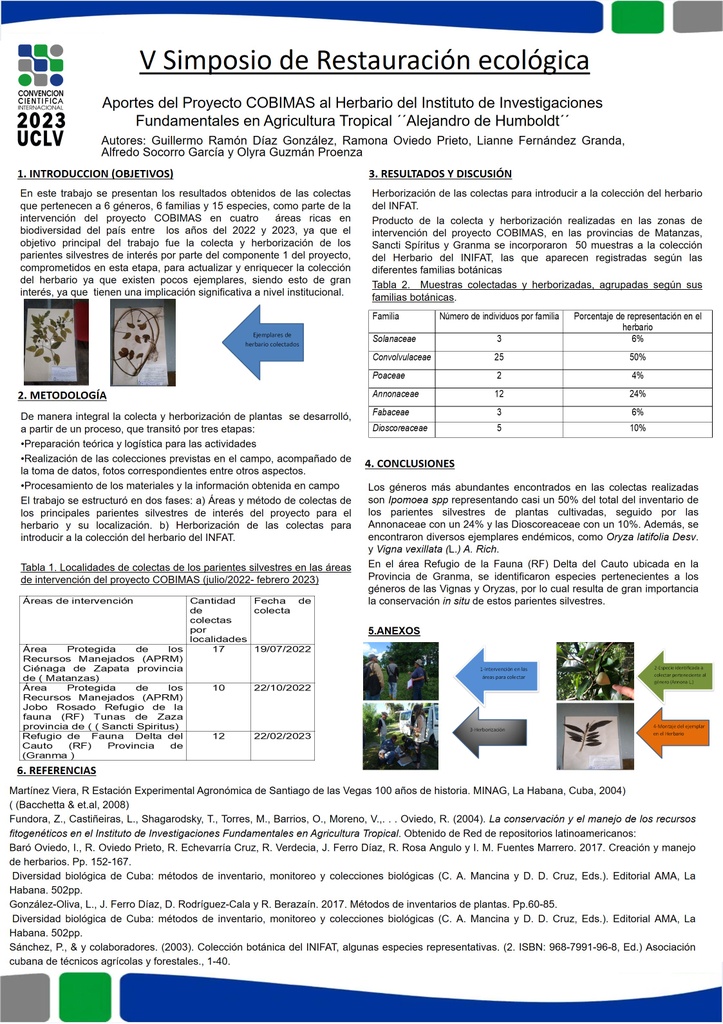Executive Secretary

9th International Scientific Conference on Agricultural Development and Sustainability
5th Symposium of Ecological Restoration

Abstract
Introduction: A herbarium is a collection of dry plants mounted on cardboard and arranged for easy consultation. The importance of this lies in having represented and systematized part of the country's plant biodiversity, for research. The “Alejandro De Humboldt” Institute for Fundamental Research in Tropical Agriculture has a herbarium whose collection is dedicated primarily to representatives of Cuban agrobiodiversity. However, the collection does not have many specimens of wild relatives. Objective: The objective of the research was to collect wild relatives of cultivated and food plants for the institution's herbarium. Materials and methods: Within the framework of the project "Introduction of new agricultural methods for the conservation and sustainable use of biodiversity, including plant and animal genetic resources, in productive landscapes in selected areas of Cuba", three expeditions were carried out, in the years 2022 and 2023, to the implementation areas: two protected areas of managed resources (Ciénaga de Zapata and Jobo Rosado) and two wildlife refuges (Tunas de Zaza and Delta del Cauto). Collections were georeferenced for future monitoring. Results and discussion: 50 samples of specimens belonging to twelve species, six genera and six families were collected. Conclusions: The most abundant genera were Ipomoea representing almost 50% of the total, followed by Annona with 24% and Dioscorea with 10%. In addition, various endemic specimens were found, belonging to the genera of Vigna and Oryza.
Resumen
Introducción: Un herbario es una colección de plantas secas montadas en cartulinas y ordenadas para su fácil consulta. La importancia de este radica en tener representada y sistematizada parte de la biodiversidad vegetal del país, para investigaciones. El Instituto de Investigaciones Fundamentales en Agricultura Tropical “Alejandro De Humboldt” cuenta con un herbario cuya colección está dedicada fundamentalmente a representantes de la agrobiodiversidad cubana. Sin embargo, la colección no cuenta con muchos ejemplares de parientes silvestres. Objetivo: El objetivo de la investigación fue colectar parientes silvestres de plantas cultivadas y alimenticias para el herbario de la institución. Materiales y métodos: En el marco del proyecto “Introducción de nuevos métodos agrícolas para la conservación y el uso sostenible de la biodiversidad, incluyendo recursos fito y zoogenéticos, en paisajes productivos en áreas seleccionadas de Cuba”, se realizaron tres expediciones, en los años 2022 y 2023, a las áreas de implementación: dos áreas protegida de los recursos manejados (Ciénaga de Zapata y Jobo Rosado) y dos refugios de la fauna (Tunas de Zaza y Delta del Cauto). Se georreferenciaron las colectas para futuro monitoreo. Resultados y discusión: Se colectaron 50 muestras de ejemplares pertenecientes a doce especies, seis géneros y seis familias. Conclusiones: Los géneros más abundantes fueron Ipomoea representando casi un 50% del total, seguida por las Annona con un 24% y las Dioscorea con un 10%. Además, se encontraron diversos ejemplares endémicos, pertenecientes a los géneros de Vigna y Oryza.
About The Speaker

Ing. Guillermo Ramón Díaz González

Discussion

